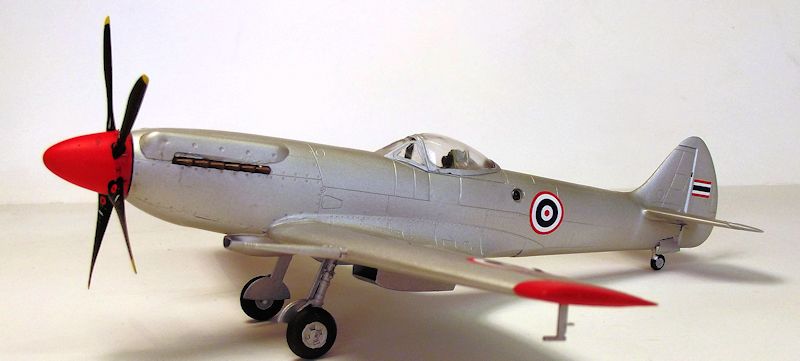
Airfix/ICM 1/48 Spitfire XIVe
| KIT #: | |
| PRICE: | Around £70-00 in total |
| DECALS: | Robbed from Academy kit |
| REVIEWER: | Frank Reynolds |
| NOTES: | Kitbash using three kits |

| HISTORY |
The Spitfire XIV was an interim type and very much a third generation evolution
of the family. A substantial
redesign of the Mk.VIII, it entered service in early 1944. It was powered by a
2,000 hp Rolls
 Royce Griffon engine and introduced a very distinctive 5-bladed
propeller. This was a wholly new style of Spitfire, heavier and more rugged, and
competitive with later generations of fighter aircraft form the World’s major
manufacturers. Late production versions introduced a cut down rear fuselage and
bubble canopy providing its pilots with greatly improved all round vision. 957
were built, so it represented barely 4% of the total production run of the
Spitfire family. A versatile aircraft it could be equipped with oblique cameras
in the rear fuselage to undertake a fighter reconnaissance role. The XIV would
see post war service in RAF Germany and the Far East and become part of the
inventory of the Air Forces of Belgium, India and Thailand. Thailand received 30
reconditioned ex-RAF aircraft that served from 1951 to 1955.
Royce Griffon engine and introduced a very distinctive 5-bladed
propeller. This was a wholly new style of Spitfire, heavier and more rugged, and
competitive with later generations of fighter aircraft form the World’s major
manufacturers. Late production versions introduced a cut down rear fuselage and
bubble canopy providing its pilots with greatly improved all round vision. 957
were built, so it represented barely 4% of the total production run of the
Spitfire family. A versatile aircraft it could be equipped with oblique cameras
in the rear fuselage to undertake a fighter reconnaissance role. The XIV would
see post war service in RAF Germany and the Far East and become part of the
inventory of the Air Forces of Belgium, India and Thailand. Thailand received 30
reconditioned ex-RAF aircraft that served from 1951 to 1955.
| THE KIT |
This is number 56 in my current collection of 1:48 scale aircraft from the
Spitfire series, just one more step on the road of my seemingly never-ending
project. It is the last of the
sub-series that sets out to represent the 29 air arms that operated the Spitfire
/Seafire family in squadron service. One variant that consistently proves a
challenge is the Mk.XIV and its close cousin the Mk.XVIII. The only current
mainstream kits of the Spitfire XIV, both high back and low back, in 1:48 scale
come from Academy. They are neatly tooled, with good decals, but rather poorly
executed in that the nose area is too bloated and to my mind it does not
accurately capture the deadly beauty of the subject. However, since one of the
Academy kits remains in my collection, a review is included below to complete
the picture.
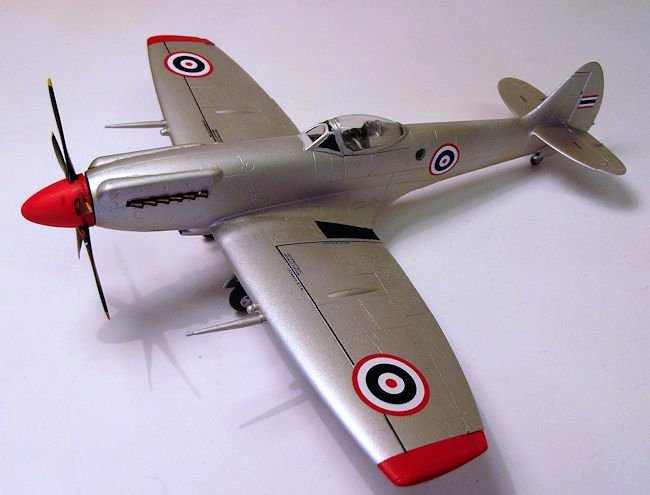 One of the by- products of this major undertaking is a massive amount of spare
parts that I have amassed from all of the kits built, a collection swollen also
by the number of scrapped airframes that I have accumulated as I have replaced
and updated some of the subjects in my showcase.
One of the by- products of this major undertaking is a massive amount of spare
parts that I have amassed from all of the kits built, a collection swollen also
by the number of scrapped airframes that I have accumulated as I have replaced
and updated some of the subjects in my showcase.
However it was by the good grace of my LHS, Spot on Models and Hobbies of
Swindon in the UK, that this latest project emerged. A careless courier had
delivered a consignment of Airfix models that really were kit bashed, the boxes
were broken and crumpled, so I was offered a couple of
PR.19s and a Seafire 46/47
on terms that I could not refuse. This gave me the confidence to try what
would normally be an expensive exercise – to combine the parts from three kits
to provide the missing link in my collection.
 two kits are almost 20 years
apart and the different tool makers have different ideas as to the exact cross
section of a Spitfire fuselage in this area, but it only required the tail parts
to be packed out slightly along the joining faces with a sliver of plastic card
and the new tail fitted to the fuselage reasonably well, requiring minimal
filler. The prominent camera windows to the rear fuselage sides were drilled out
at the same time.
two kits are almost 20 years
apart and the different tool makers have different ideas as to the exact cross
section of a Spitfire fuselage in this area, but it only required the tail parts
to be packed out slightly along the joining faces with a sliver of plastic card
and the new tail fitted to the fuselage reasonably well, requiring minimal
filler. The prominent camera windows to the rear fuselage sides were drilled out
at the same time.
| CONSTRUCTION |
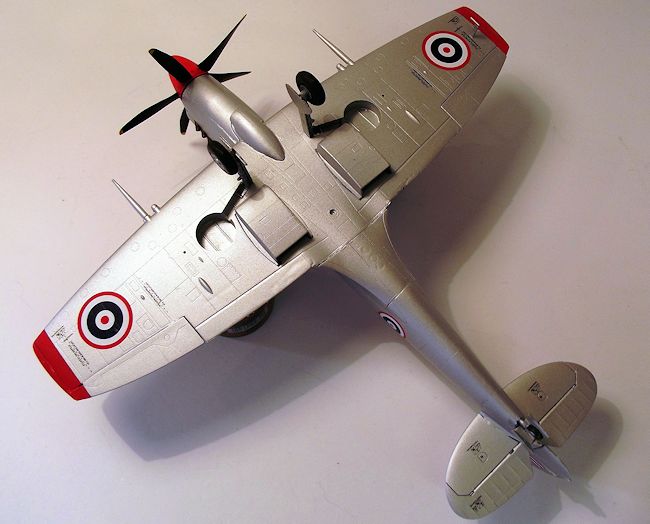 Green
from the Xtracrylix range with details such as the control stick , rudder pedals
and head rest picked out in Flat Black.
Green
from the Xtracrylix range with details such as the control stick , rudder pedals
and head rest picked out in Flat Black.
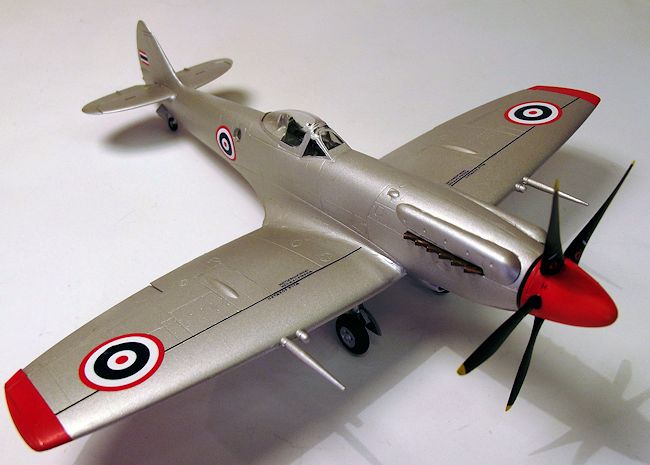 came from the Airfix Seafire 46 mouldings.
came from the Airfix Seafire 46 mouldings.
Left to settle for 24 hours and with transparencies masked, the whole airframe
was sprayed with auto primer from a rattle can to show up any dings and
scratches which were treated with Revell Plasto filler and the primer then
touched in.
| COLORS & MARKINGS |
The missing subject in my collection was the Air Force of Thailand, a subject
long overdue but one that I had been putting off due to the complexity of the
project. . Ironically, the very decals that I needed came from Academy, in a
Spitfire XIVe kit that I have now rejected as being too inaccurate for long term
use in my collection. Academy produced a “Special Edition” boxing that went into
my stash a few years ago, kit No. 12211. It includes a fabulous A4 size decal
sheet by Cartograph with seven options for exotic and unusual Spitfire XIVes,
being the Indian Air Force in two roundel styles, RAF Germany 1946, Belgian Air
Force, Royal Thai Air Force and even a Canadian civil registered aircraft form
the Cleveland Air races in 1949.
The decals are perfectly printed in good register with strong colours and
include full stencilling for one airframe.
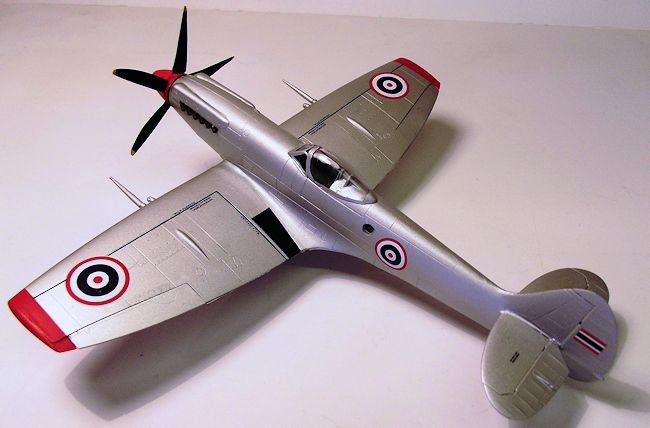 ips picked
out in Tamiya XF-1 Flat Red.
ips picked
out in Tamiya XF-1 Flat Red.
The Thai aircraft are not well documented and are fairly anonymous, even lacking codes and serial numbers so the paint scheme is stark and simple, but presents one dilemma that occurs with other Spitfires in my collection, that of airframe stencilling. Is it worded in the subject’s language? With poor photo references available I have no real idea, even if such decals were available, which is highly unlikely, so I contented myself with a few electrical earth stencils, the “No step” messages around the wing walk lines and the under wing trestle markings. Just to add a touch of contrast I used a wing root walkway decal from the PR.19 sheet. The final touch was to complete the airframe with two misted coats of Xtacrylix Flat varnish.
| CONCLUSIONS |
This has to be an exercise for a seriously obsessed Spitfire collector. If I had
not been “gifted” two damaged kits this would have been an expensive exercise.
It involves the sacrifice of an Airfix Seafire 46/47; an Airfix Spitfire PR.19;
an ICM Spitfire IX/XVI and the purchase of an Academy FR.XIVe for the
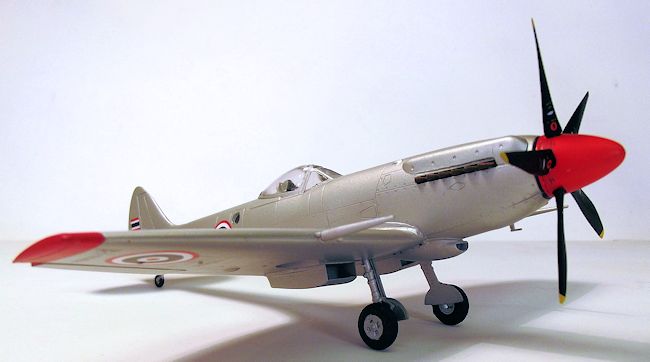 decals. I
make that around £70-00 at UK prices.
decals. I
make that around £70-00 at UK prices.
| REFERENCES |
Spitfire International by Helmut Terbeck, Harry van der Meer and Ray Sturtivant,
Air Britain (Historians) Ltd 2002
Spitfire, the History by Eric B. Morgan and Edward Shacklady, Key Publishing,
2000
August 2014
Project
courtesy of my LHS, Spot on Models & Hobbies of Swindon, England.